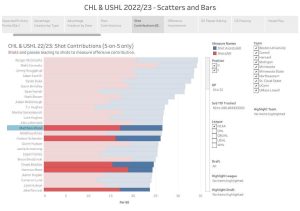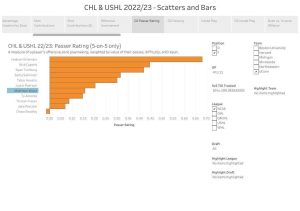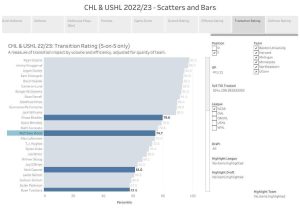Welcome back to Top Shelf Prospects, the column that brings you the next crop of professional hockey players. Each day our LWOS Prospects Writers will bring you a new player profile or topical article in the lead-up to the 2023 NHL Draft. Be sure to bookmark the site, follow Ben Kerr, Kyle Pereira and Frederik Frandson on Twitter, and spread the word for the site that will bring you analytical and critical profiles and scouting reports! Last Word On Hockey Prospects is your new headquarters for everything “NHL Draft”! Today we bring you our Matthew Wood Scouting Report.
 Wood, who was born February 6th, 2005 in Lethbridge, Alberta, is a forward playing out of the University of Connecticut. He stands at 6’3” and 190 pounds, making him one of the bigger top prospects in the class. Playing primarily left wing for the Huskies this season, he finished with 11 goals and 23 assists for 34 points in 35 games. The year before that, he played in the BCHL and potted 45 goals and 40 assists for 85 points in 46 games.
Wood, who was born February 6th, 2005 in Lethbridge, Alberta, is a forward playing out of the University of Connecticut. He stands at 6’3” and 190 pounds, making him one of the bigger top prospects in the class. Playing primarily left wing for the Huskies this season, he finished with 11 goals and 23 assists for 34 points in 35 games. The year before that, he played in the BCHL and potted 45 goals and 40 assists for 85 points in 46 games.
With the NCAA production as a true freshman, Wood has largely been ranked as a first-round level talent. He has been ranked between 14th and 33rd by various experts and sites. Those rankings include 14th by Bob McKenzie, 16th by The Hockey News, 18th by Craig Button, 20th by Daily Faceoff, 21st by Elite Prospects and SportsNet, 24th by McKeen’s Hockey, 25th by Draft Prospects Hockey, 27th by FCHockey and Recruit Scouting, 31st by Smaht Scouting, and 33rd by DobberProspects.
Matthew Wood Scouting Report
Right Wing/Left Wing — shoots Right
Born February 6th, 2005 — Nanaimo, British Columbia
Height 6’4″ — Weight 193 lbs [193 cm / 88 kg]
Matthew Wood Deep Dive
Wood looks to be a mid-to-late first round pick. However, he possesses the size NHL GM’s covet and has the NCAA production to show that he isn’t just all size. Is he the next Tage Thompson in the making?
Wood’s Skating
The biggest thing that stands out for Wood is his skating. And it’s not a good reason. His top speed severely lacks at the NCAA level, and it at times leaves him scrambling to catch up or missing out on breakaway opportunities as the defenders can catch up. Wood needs a massive makeover on his skating if he wants to be even average at the NHL level, which isn’t the biggest ask, but will take time.
The good news is that his acceleration is fine. He has a powerful lower body, which allows him to generate good power off his first few strides. Some may argue short bursts and winning short races to loose pucks is more important than long speed at times, and Wood can at least hold up okay in that area.
Offensive Abilities
Matthew Wood obviously has produced well both in the BCHL as a 16/17-year-old and as a true freshman in the NCAA. The reason for this is his surprisingly high end stick handling. With the long reach he possesses, along with the stickhandling skill, he can protect the puck for long periods of time, while also being able to play keep away with the opposing defenders. There are times where he can make your jaw drop. But his overall playmaking is largely inefficient. He’s a shoot-first player, and can pass off the smarter and better pass for a low-danger shot that gets blocked away. Additionally, there are times where he attempts to do too much and turns the puck over. Working on his vision and passing skills will go a long way for him, as he has the hands and creativity to create space and time for himself and teammates.
Meanwhile, his shot is high end. Wood has a cannon of a shot, with incredible power. It comes off his stick smoothly and efficiently. He has a quick release and can change the angle of his shot as well. His accuracy needs to be more consistent, but that comes with time. An area he needs to work on, however, is using his size more offensively. There are times where he could use his size to get to loose pucks and score a greasy goal, but fails to do so. It’s not like he lacks physicality, as he will finish his checks, it just isn’t very often. More aggression, especially at net-front, would help his scoring abilities even more.
Shooting Ability
Starting with his bread and butter, let’s look at Wood’s shooting. Using Lassi Alanen and Mitch Brown’s tracked data, they tracked Wood’s shooting efficiency. He ranked 14th this season, amongst NHL prospects playing in the NCAA, in shot contributions at 5-on-5. That was one spot ahead of Matt Knies.

As the chart shows, his shooting efficiency is predicated on a large volume of shots. However, also shown is that he generates a good amount of shot assists as well. While he isn’t among the best shooters, it is extremely important to remember he is a true freshman and surely will improve next season. That said, this is impressive for him at the NCAA level.
Playmaking Ability
Not to harp on this too much, but as mentioned earlier, Wood does not possess the best playmaking skills. Again, he can pull off some ridiculous dekes and dangles to get past opposing defenders. But the passing skill just was not there this season. Again, let’s look at the tracked data from Alanen and Brown. This time, using their passer rating metric, which measures the difficulty of the pass attempted, the value of the pass that was attempted, and the result of that pass.

This bar graph may seem different than any of the ones shown in previous articles. That’s because he was not near the top in passer rating amongst NCAA forwards. To show his standing, it needed to be limited to just UConn forwards. On a list of 11 teammates, he ranked seventh. It’s clear, at this point, that Wood really needs to improve his passing. In particular, his vision and willingness to pass the puck more.
Ryan Leonard’s Transitional Abilities
On the surface, Wood doesn’t seem like the type of player to succeed transitionally. He’s big, not a very good skater, and lacks the vision and passing skills on offence, which could show up when transitioning up ice. Add in the fact he is a true freshman on a strong UConn roster, it’s likely he plays with someone more adept at moving the puck up ice. But that’s not entirely the case.
Diving Deeper Into The Transitional Numbers
Wood was not the most efficient puck mover for UConn. In one tracked game, he was involved directly in 11 zone exit attempts, and he successfully exited the defensive zone with control on six of them (54.55% rate). Meanwhile, he was involved in six zone entry attempts, with three successfully gaining the offensive zone with control (50% rate). But what stood out was how often Wood was given a chance by teammates. It was fully due to his positioning. He rarely ever cheated up ice, keeping himself low for an easy outlet pass. That understanding shows a high IQ, and it allowed him to be involved as much as he was.

Now, one game is a tiny sample. But Alanen and Brown had more, over 100 minutes of ice time to be exact. As shown above, he graded out well, ranking 15th out of all the NCAA forwards they tracked this year. But again, it was how often he made himself open in the neutral zone that enabled him to grade out well. That ability to find open ice consistently will translate well, if he can stay consistent.
Matthew Wood’s Defensive Zone Play
When it comes to defending in his own end, Wood can excel at times. His large frame and long reach allows him to take up space and clog up passing lanes effectively. As mentioned with his transitional play, he again stays low and helps defend the cycle. With his size, he doesn’t struggle much with the cycle game. He also does not shy away from helping defend the low-to-mid slot. He has a high involvement rate as well, which stems from his awareness to remain low to help his teammates defend and give them an option.
The biggest issue with Wood’s defensive game is his lack of foot speed. If he is caught up ice on offence, he oftentimes is the last defender back. Otherwise, he backchecks hard when he can cut off the attacker using angles. His active stick and positioning causes issues for the opposition as well. His size and short area burst also helps him win battles for loose pucks.
Matthew Wood’s Potential
Wood is an interesting player. He is big, with a heavy shot, a surprisingly efficient transitional game, and a largely solid defensive game. What he lacks in foot speed, he matches with a combination of IQ and high end stickhandling. If Wood can put together his skating and playmaking abilities, he has the makings of a future first line forward. If he cannot put all the missing pieces together, he still may make it to the NHL, but in a bottom six role. It all depends on how well he is used by his future team and how much he can improve on those weaknesses over the next two to three years.
NHL Comparison
Based only on style, and not projecting a player’s traits or how well a player will perform, Matthew Wood plays a very similar style to Tage Thompson. Thompson is a shoot-first player, with a powerful shot. His stickhandling and creativity has led him to become one of the most exciting and talked about players in the NHL. Yet, despite his size, he isn’t the most physical. The reason Thompson was able to take his big frame and become the player he is today is due to the fact that his offence isn’t one-dimensional and he is a very surprisingly good skater, especially with his frame. He is the blueprint for Matthew Wood, and if Wood can improve on the areas touched on above, he could join Thompson on some highlight reels.
Highlights
Tracked Stats from Lassi Alanen and Mitch Brown
Tracked Transitional Stats from Kyle Pereira (when specified)
Raw stats via Elite Prospects
Main Photo: Anne-Marie Sorvin-USA TODAY Sports






